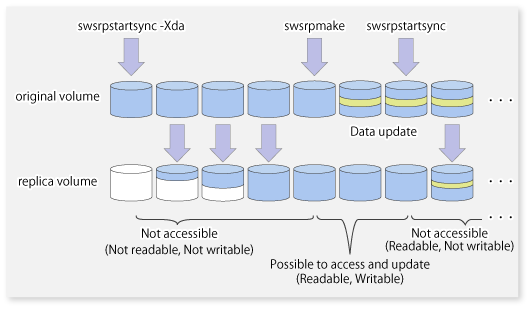To perform synchronized replication, use the following procedure:
Start synchronized processing using swsrpstartsync (Synchronous processing start command). Use swsrpcancel (Replication cancellation command) to cancel synchronized processing that has already started.
After making sure that equivalency maintenance state has been established with swsrpstat (Operation status display command), temporarily stop synchronized processing with swsrpmake (Replication creation command) to create a replica of the source volume.
To copy the updated (ie, incremental) data, restart synchronized processing with swsrpstartsync (Synchronous processing start command).
Intra-box synchronous replication creates a replication from a source volume to a destination volume by using the EC function of ETERNUS Disk storage system.
The EC function operates in a mode in which a copy is made to a destination volume in synchronization through a write to a source volume (ie, in synchronous mode).
It is also possible to reverse the copy direction from suspend status using the EC functionality.
Inter-box synchronous replication creates a replication from a source volume to a destination volume by using the REC function of ETERNUS Disk storage system.
The REC function provides three copy operation modes that can be selected for operation:
Transfer mode
Recovery mode
Split mode
In addition, the REC function enables the copy direction to be reversed in suspended status.
Transfer mode
The transfer mode provides the REC data transmission modes described below.
Transfer method | Transfer mode | Explanation |
|---|---|---|
Synchronous transfer method | Synchronous | In this mode, responses to write requests from the server do not return as "complete" until data has been written to the copy source volume and copied to the destination volume. Synchronizing data copies with writes to the copy source guarantees the integrity of the data on both the copy source volume and the copy destination volume when the copy completes. This mode is suitable to RECs within sites with short delay times, because it has a large impact on the performance of write accesses from the server. |
Asynchronous transfer methods | Stack | This mode has only a small impact on the time taken to respond to the server because it only records the position of the block that has been updated before returning "complete" to the server. The data for this block is transferred using an independent transfer engine. Copies can be executed even when there is only limited bandwidth, but in this case the amount of data that has not been transferred may build up. |
Consistency | This mode guarantees the sequence of transfers between copy sessions for the copy destination ETERNUS Disk storage system, and is suitable for operations, such as on databases, that perform mirroring using copies that consist of multiple areas. This mode uses part of cache memory for transfer buffers. Data is transferred to the copy destination by first "storing" a block of data to be copied in a transmission transfer buffer and then using a reception transfer buffer to "expand" the data that has been transferred. | |
Through | This mode is for transferring data that has not been transferred when copies in Stack mode or Consistency mode are stopped or suspended. |
To perform a synchronous replication in Stack mode or Consistency mode, use swsrpstartsync (Synchronous processing start command), swsrpmake (Replication creation command), and swsrpchsync (Synchronization mode change command). To check the execution status, use swsrpstat (Operation status display command). The figures below show how synchronous replication is performed in Stack mode or Consistency mode.
Figure 7.31 Flow of synchronous replication (for Stack mode/Consistency mode)

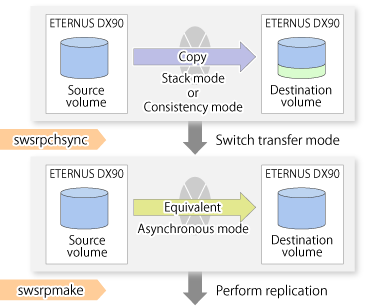
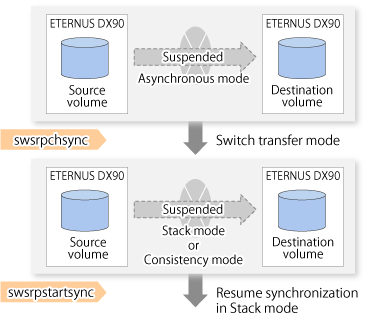
Note
If the equivalency maintain status REC operating mode is changed, after the operating mode is changed, the user must wait until the equivalency maintain status is attained.
Recovery mode
Recovery mode consists of two methods of restarting the copying after recovery is performed from an inter-box path error (e.g., halt status).
Mode | Description |
|---|---|
Automatic Recovery | In this mode, the REC session automatically switches from halt status to regular status, and copy processing resumes when the inter-box FCRA path is recovered. |
Manual Recovery | In this mode, the REC session remains in halt status and copy processing does not resume even if the inter-box FCRA path is recovered. Manually resume copying. This mode is used, for example, when operating a standby database. |
Split mode
Split mode includes two modes for performing a write operation to the source volume when REC is used for synchronous transfer mode, and for recovery from an inter-box path error (halt status).
Mode | Description |
|---|---|
Automatic Split | This split mode forcibly executes successful write operations to source volumes even if the inter-box FCRA path is fully blocked and halt status occurs. This mode enables write operations to source volumes even if the inter-box FCRA path is fully blocked, thus this mode does not affect transactions. When the inter-box FCRA path is recovered, copy processing resumes according to the recovery mode configurations. |
Manual Split | This split mode rejects write operations to source volumes (it returns an error) if the inter-box FCRA path is fully blocked and halt status occurs. This mode enables source volumes and destination volumes to be fully synchronized even if the FCRA path is fully blocked. When the inter-box FCRA path is recovered, copy processing resumes according to the recovery mode configurations. |
Copy direction reverser
The copy direction reverser allows you to smoothly switch between different sites.
The following figures show an example of how to switch the copy direction:
Assume that Site A is operating and REC is operating from Site A to Site B.
Figure 7.32 When REC performed from Site A to Site B
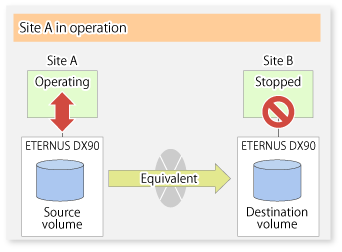
To switch the sites, execute swsrpmake (Replication creation command) to make a replication to Site B. Then, stop operating Site A.
Figure 7.33 When replication creation command used to create a replica at Site B
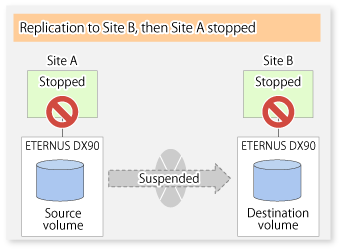
Execute swsrprevsync (Synchronization reverse command) to reverse the copy direction.
Figure 7.34 When the synchronization reverse command is executed

Bring Site B into operation. At this stage, synchronization is still suspended, thus any update to the volume at Site B is not reflected at Site A.
Figure 7.35 When operation is started at Site B (synchronization suspend state)

Start (resume) synchronization from Site B to Site A. Updates made to the volume in Site B while synchronization is suspended are reflected in Site A with differential copies.
Figure 7.36 When operation is started at Site B (synchronization resumed)

The initial copy skip function is used when the initial copy cannot be executed because of insufficient line capacity.
The following example shows the initial copy being skipped via tape transfer.
Suppose that operations at Site A have stopped.
Figure 7.37 If operations at Site A have stopped

Next, synchronous processing begins, using the initial copy skip function. At this point, a REC session is set up, and the status is Replication Established. Data is not copied to the copy destination volume.
Figure 7.38 When synchronization is started by the initial copy skip function
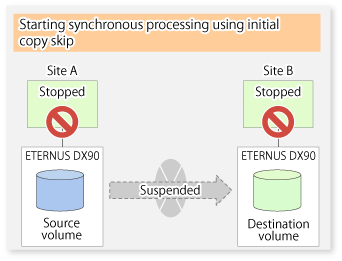
Next, the data on the copy source volume is backed up to tape.
Figure 7.39 When copy source data is backed up to tape
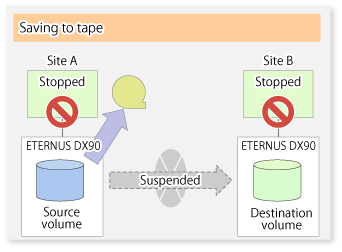
The tape medium is sent to Site B and jobs at Site A restart.
Figure 7.40 When Site A operations restart

The data on the tape medium is restored to the copy destination volume. At this point, the data on the copy destination volume is the same as the data on the copy source volume that existed before operations restarted.
Figure 7.41 When data is restored from tape to the copy destination

Synchronous processing restarts in Remain mode. Restarting synchronous processing in Remain mode means that only data that has been updated on the copy source volume is reflected on the copy destination volume. If Remain mode is not used, all data on the copy source volume is copied.
Figure 7.42 When synchronization is restarted in Remain mode
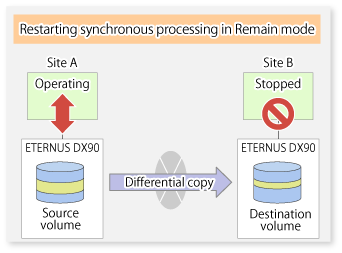
The concurrent suspend function simultaneously suspends multiple EC/REC sessions for ETERNUS Disk storage system.
By using this function, a copy with consistency can be easily taken.
For example, this is useful for a database composed of multiple volumes.
The behavior that takes places within the ETERNUS Disk storage system is shown below.
Figure 7.43 Internal operation of ETERNUS Disk storage system

Replication using the concurrent suspend function is performed by specifying the -Xconcur option for swsrpmake (Replication creation command).
Additionally, if concurrent suspend is performed using the Consistency transfer mode, it is no longer necessary to make temporary mode changes during multiple creation processes. (Refer to the figure below). Accordingly, the operating procedure used when concurrent suspend is executed in Consistency mode is the same as the procedure for Through mode and Synchronous mode.
Figure 7.44 When Consistency mode used
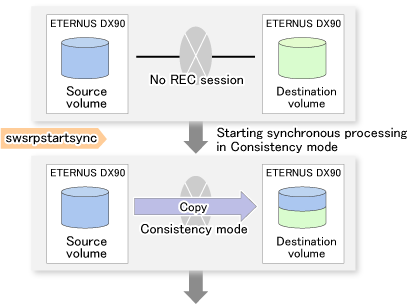
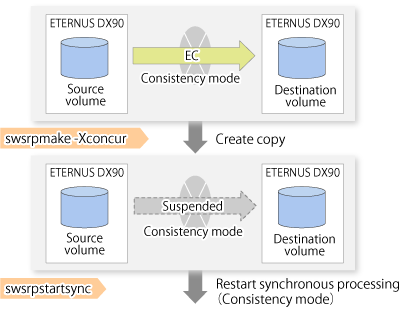
A timeout may occur before suspend is completed if there is a large quantity of data, if the communication link is poor, or if the REC Disk buffer is used for inter-box synchronous replication (REC function) in Consistency mode.
If the REC Disk buffer is used, refer to "7.5.2.3.2 Concurrent suspend when the REC Disk buffer is used".
The following message is shown if it timeout.
swsrp2709 Concurrent suspend failed. Session ID=[-], Reason=[timeout]
If this message is shown, change the value of timeout by creating a file which sets the timeout value. Create a file which sets the timeout value for the concurrent suspend function under the following name. The file must be created on the same server that contains the source volume.
<Environment directory>\etc\repl\data\DEFAULT\check.ini <Environment directory for logical node>\etc\repl\data\DEFAULT\check.ini
Section name | Key name | Value |
|---|---|---|
[check] | ConcurCheckTimeout | Set the timeout value for the concurrent suspend function in units of seconds. Setting range: From 1 to 2147483647 sec. If you set a value beyond this range, the default value 60 sec will be applied. |
Setting the timeout value for the concurrent suspend function to 120 seconds.
[check] ConcurCheckTimeout=120 |
If the setting file for the concurrent suspend function is not created, the default value (60 seconds) will be applied.
If the REC Disk buffer is used for inter-box synchronous replication (REC function) in Consistency mode, check that no transferred data exists in the REC Disk buffer before executing the concurrent suspend.
If you execute the concurrent suspend when any data to be transferred exists in the REC Disk buffer, timeout may occur.
You can check the data volume of the REC Disk buffer in the DiskRate column when you execute swsrprecbuffstat (REC buffer information display command) with specifying -L option.
The Destination Access Permission function serves to inhibit user access to replication target volumes when copying is in progress and any access would therefore be inappropriate.
It starts synchronization (EC/REC) from the replication source volume to the replication target volume, and when full or differential copying is complete, they are maintained in a state of equivalency.
In the state of maintained equivalency, any upgrades on the replication source volume are successively reflected on the replication target volume, so that any access to the replication target volume would possibly be inappropriate.
The Destination Access Permission function can be used to inhibit access from users to the replication target in such unsuitable moments.
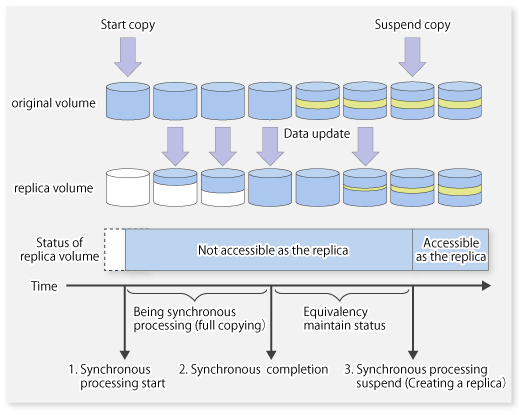
To set the Destination Access Permission function, execute swsrpstartsync (Synchronous processing start command) with specifying the -Xda option. Until replication processing is stopped by swsrpcancel (Replication cancellation command) neither WRITE nor READ access to the replication target volume can be performed.
For changing this setting, once the replication operation has been stopped by swsrpcancel (Replication cancellation command), execute swsrpstartsync (Synchronous processing start command) again.
Whether access is inhibited can be checked by performing swsrpstat (Operation status display command).
